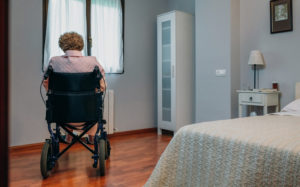
A recent report published in the New York Times reinforces concerns that staffing levels in Medicare-assisted living facilities are alarmingly inadequate. The report analyzed payroll records of nursing home aides, nurses and employees, yielding hard evidence that Medicare’s 5-star rating system for nursing home facilities is seriously flawed and greatly exaggerated day-to-day staffing levels.
Kaiser Health News analyzed payroll figures from 14,000 nursing homes across the nation, as mandated by the Affordable Care Act passed in 2010. The data revealed that nursing homes rated highly for good staff-to-resident ratios on the Nursing Home Compare website run by the government, were seriously short-staffed on occasion. As an example, one nursing home facility – on its worst day – had just one aide for every 18 residents.
Nursing Homes Short on Staff
In response to this new information, The Centers for Medicare & Medicaid Services stated it “is concerned and taking steps to address fluctuations in staffing levels.” The agency is responsible for routine nursing home inspections and confirmed that it would lower ratings for assisted living centers that had gone 7+ days without a registered nurse. This admirable intention may be cold comfort for families who entrusted the care of their loved ones with nursing homes that earned 5-star ratings – facilities that may be too understaffed to provide adequate care.
Nursing home workers are relied upon for a number of daily tasks, from feeding and bathing to making sure residents get appropriate medications. Understaffing puts tremendous pressure on aides, reducing the quality of patient care, and leading to high levels of employee turnover. Research has shown that nursing homes with lower staffing numbers are more likely to be cited with health code violations — a telltale sign that something is seriously wrong.
Understaffing Negatively Impacts Patient Care
There are currently some 1.4 million seniors residing in U.S. nursing homes. Workers in understaffed facilities simply do not have the resources to pay attention to every small detail, which can lead to medication errors, preventable injuries, and sometimes death.
Patients who are bedridden or suffer from severe cognitive decline are at greatest risk for injury in understaffed homes. Essential tasks like bathroom visits or turning an immobile patient over are overlooked. This neglect leads to avoidable falls, hospitalizations, infections, bedsores and other trauma.
Overworked and overburdened staff cannot provide the standard of care necessary for nursing home residents. Staffing issues have been connected to a number of abuse reports in nursing homes across the country, including:
- Bed sores
- Infections requiring hospitalization
- Abnormal weight loss
- Malnutrition and dehydration
- Inadequate medical care
- Preventable falls from lack of supervision
Neglect has physical and emotional consequences on nursing home residents, who often become depressed from the lack of social interaction. When understaffing leads to neglect and patients suffer, the law affords remedies.
Nursing home neglect attorneys serving NJ and NY
If you suspect neglect or mistreatment of your loved one, contact Kantrowitz, Goldhamer & Graifman for a free consultation with nursing home abuse lawyers in Bergen County, NJ and Rockland County, NY. We will review your case to determine if you have grounds for compensation. We handle nursing home abuse cases in New York and New Jersey on a contingency basis.
Additional Resources:
- NY Times, It’s Almost Like a Ghost Town.’ Most Nursing Homes Overstated Staffing for Years https://www.nytimes.com/2018/07/07/health/nursing-homes-staffing-medicare.html
- NY Times, Staffing Fluctuates at Nursing Homes Around the United States https://www.nytimes.com/interactive/2018/07/07/health/nursing-home-map.html?action=click&module=RelatedCoverage&pgtype=Article®ion=Footer
